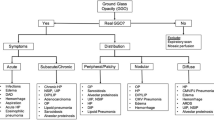Abstract
99mTc colloid scintigraphy is a sensitive technique for the detection of gastro-oesophageal reflux, compared to X-ray studies. A quantification index of reflux is used and can be of value when there is concern about the significance of a positive result. Continuous monitoring during one hour increases by 25% the detection of reflux in comparison with a 30 min test. In our series, no case of lung aspiration was recognized using this technique. The scintiscanning index cannot predict the existence of an associated oesophagitis.
Similar content being viewed by others
References
Arasu, TS, Franken EA, Wyllie R, et al (1980). The gastro-esophageal scintiscan in detection of G. E. reflux and pulmonary aspiration in children. Ann Radiol (Paris) 23: 187
Arasu TS, Fitzgerald JF, Franken EA, et al (1980) Gastro-eosphageal reflux in infants and children-comparative accuracy of diagnostic methods. J Pediatr 96: 798
Blumhagen JD, Christie DL (1979) Gastro-esophageal reflux in children: evaluation of the water siphon test. Radiology 131: 345
Blumhagen JD, Rudd TG, Christie DL (1980) Gastro-esophageal reflux in children. AJR 135: 1001
Boonyaprapa S, Alderson PO, Garfink DJ, Wagner HN (1979) Detection of pulmonary aspiration in infants and children (Abstract). J Nucl Med 20: 680
Conway JJ, Weiss SC, Luck SR, Goldstein RI (1979) Radionuclide evaluation of gastro-esophageal reflux in children (Abstract). J Nucl Med 20: 680
Devos PG, Forget P, De Roo M, Eggermont E (1979) Scintigraphic evaluation of gastro-esophageal reflux in children (Abstract). J Nucl Med 20: 636
Fisher RS, Malmud LS, Roberts GS, Lobis IF (1976) Gastro-esophageal scintiscanning to detect and quantitate reflux. Gastroenterology 70: 301
Heyman S, Kirkpatrick JA, Winter HS, Treves S (1979) An improved radionuclide method for the diagnosis of gastro-esophageal reflux and aspiration in children. Radiology 131: 479
Johnson LF, Demeester TR (1974) Twenty four hour pH monitoring of the distal oesophagus. Am J Gastroenterol 62: 325
Kay MD (1977) Postprandial gastro-esophageal reflux in healthy people. Gut 18: 709
Rudd TG, Christie DL (1979) Demonstration of gastro-esophageal reflux in children by radionuclide gastro-esophagography. Radiology 131: 483
Thirunavukkarasu S, Siddiqui AR, Wyllie R, et al (1979) Usefulness of radionuclide studies in detection of gastro-esophageal reflux and pulmonary aspiration in children (Abstract). J Nucl Med 20: 637
Author information
Authors and Affiliations
Rights and permissions
About this article
Cite this article
Piepsz, A., Georges, B., Perlmutter, N. et al. Gastro-oesophageal scintiscanning in children. Pediatr Radiol 11, 71–74 (1981). https://doi.org/10.1007/BF00971782
Accepted:
Issue Date:
DOI: https://doi.org/10.1007/BF00971782




